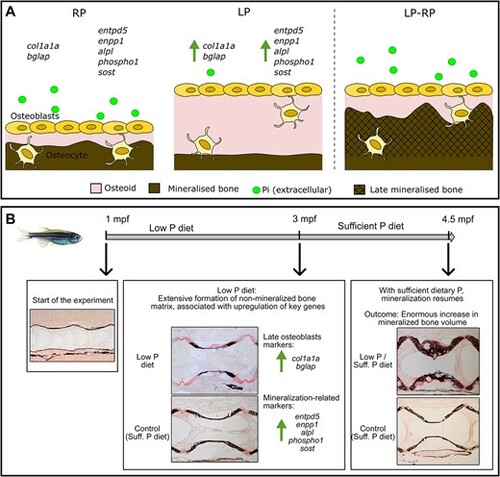Fig. 6
- ID
- ZDB-FIG-240724-11
- Publication
- Cotti et al., 2024 - Matrix first, minerals later: fine-tuned dietary phosphate increases bone formation in zebrafish
- Other Figures
- All Figure Page
- Back to All Figure Page
|
Schematic view of the effects of dietary P intake on bone formation and mineralization. (A) In presence of regular dietary P (RP), the non-mineralized bone matrix secreted by osteoblasts, named osteoid, mineralizes after deposition. When low dietary P (LP) is provided, bone matrix production is stimulated, accompanied by the increased expression of the osteoblast specific markers collagen type I (col1a1a) and osteocalcin (bglap). Under LP conditions, genes important for bone mineralization are upregulated, such as the ectonucleotide pyrophosphatase phosphodiesterase 1 (enpp1), the ectonucleoside triphosphate/diphospho-hydrolase 5 (entpd5), the tissue non-specific alkaline phosphatase (alpl), the phosphatase orphan 1 (phospho1), and sclerostin (sost). Thus, under LP conditions, osteoblasts increase the production of non-mineralized bone matrix and the expression of genes required for mineralization. When sufficient dietary P is provided (LP–RP), the mineralization of the non-mineralized matrix resumes, resulting in increased mineralized bone volume. (B) Summary of the main results of the zebrafish dietary P experiment. The LP diet stimulates bone matrix formation first associated to upregulation of key genes. Upon sufficient dietary P administration, newly formed bone matrix mineralizes, resulting in enormous increase in mineralized bone volume. |

